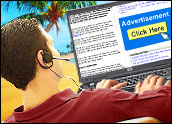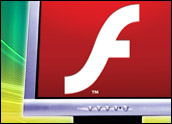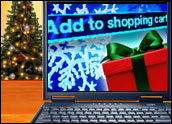
Designing company websites has evolved into an art form, and much attention is paid to selecting the appropriate colors, using the right graphics, and making sure the content best reflects the corporate messaging and brand.
These are absolutely areas of importance, but often companies design their websites to be aesthetically pleasing without providing clear, easy ways for visitors to take action in order to experience the service or product. As a result, people can’t complete their tasks and leave frustrated, never to return. Unless there are distinct calls to action that draw attention, it’s unlikely they’ll progress from being “visitors” to being customers.
It’s easy to prevent this from happening. A “call to action” in Web design describes a specific element on a page that solicits an action from the user. Basically, it represents what you’d like the visitor to do to further engage, i.e., sign up for a product/service trial, purchase something or add it to an online shopping cart, subscribe to a newsletter.
The most common way to showcase a call to action is through a clickable button, accompanied by a textual directive (“Buy now”). Putting a button on your homepage may seem intuitive and simple, but it should not be done haphazardly. It’s important to keep the following best practices in mind when creating an optimal call to action.
You must know your audience in order to design effective calls to action that will elicit the desired response.
For whom are you designing the call to action? First, consider your target audience and the value proposition you offer.
What are the users’ goals? Are you offering them something of value if they act? Do you effectively convey this value to them in a way that’s easily identifiable from their perspective? Do you clearly convey the benefits of selecting your product or service?
Once you have designed the calls to action with these considerations in mind, then conduct A/B tests to validate that your design is effective and understand which factors are more likely to lead to conversion with your audience.
A/B tests, sometimes called “bucket tests,” involve determining which design elements encourage the most positive responses. Using your current website or landing page as a control, make one design change (different colored text, alternate wording, etc.) and measure your conversion rate or the percentage of people who follow through on the action.
Over time, you’ll learn which changes consistently engage users the most, and you can then incorporate a combination of them to improve your call to action.
Make sure your call to action reinforces the appeal of your product or reiterates the value consumers will get from taking the action.
The text on your buttons should begin with a verb (e.g. Buy now, Get a quote, etc.) Consider the language from the users’ perspective. What would users say if they had to tell you what they were trying to do?
Typically, organizations use different terms from those their customers use — for instance: “estimate” vs. “quote” or “fees” vs. “cost.” Keep that in mind when labeling buttons. The buttons should clearly convey the action that users expect while still being concise.
It’s also important to emphasize to consumers the benefits of proceeding with the action. Relying on a directive like “try it now” for a call to action is generic in and of itself. However, if you reinforce that the service they’re trying is a 30-day free trial with no obligations — well, there’s no drawback in going for it!
Where applicable, employ phrases that generate a sense of urgency to convince users that they shouldn’t wait and miss the opportunity. For example, “temporary price reduction — buy now!” is more motivating than “on sale.”
Every time you ask a prospective customer to take action, you imply that you can provide a unique value proposition. Carefully consider your most important calls to action, have a small number of distinct actions the prospect can take, and draw attention to those effectively.
The appropriate number can vary from site to site, depending on business goals and objectives. However, providing too many options can overwhelm users and encourage them to abandon your site altogether. Playing up the unique benefits of each action is pivotal in compelling users to go forward.
Design buttons that grab users’ attention and entice them to click.
Make your buttons large and easily discoverable. The bigger they are, the more likely they are to be noticed. The optimal size really depends on the context. You need to compare the button to the surrounding objects and ensure it is large enough to draw attention. Using white space or dead space around a call to action can also effectively distinguish it from surrounding elements on the pages.
This is especially important if your website has several calls to action, in which case you can use size to indicate the relative importance of each. The most important action button or primary action should be the largest; if you prefer that users sign up for a product trial over signing up for a newsletter, you should make the trial button larger and more pronounced. The secondary call to action, signing up for a newsletter, should be smaller.
Placement is also critical for drawing the eyes and attention of users. First and foremost, the calls to action that are especially important must be above the page “fold,” in the visible area, so users don’t have to scroll down to locate them. Be sure to test your website to make sure the button actually shows up above the fold at a minimum resolution of 1024 x 768.
Additionally, consider the typical user’s eye pattern and design accordingly. The most valuable real estate on a page is the upper left corner. Users tend to focus their gaze on the left side of the body of a Web page when reading and fixate very little on information located on the right-hand side, according to Jakob Nielsen.
Consider this reality in button placement. It’s widely acknowledged that placing buttons in a prominent location, like the top section of a Web page, leads to higher landing page conversions.
If by chance you’d prefer to put the buttons in the center of the page, perhaps embedded in a graphic, make sure the color contrast is high and there is enough space around the button to draw attention to it so that it doesn’t get lost. Using high-contrast colors relative to the surrounding elements on the page and background will emphasize the button.
Furthermore, think about the message that is conveyed with the color selection — red attracts attention but is also frequently used to indicate errors, whereas green is typically associated with “go.”
By investing the thought, time and consideration involved in creating successful calls to action, you’re literally clarifying the window in which prospective customers see you and can guide them through an experience that both addresses their needs and achieves your business goals. It’s a win-win for all.
Paula Selvidge, Ph.D., is vice president of products and user experience atPerfectForms.















































Social Media
See all Social Media